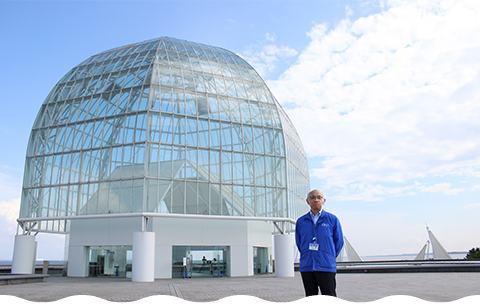
A. I am currently at Tokyo Sea Life Park, but soon after being hired by the Tokyo Metropolitan Government, I was placed in charge of agriculture, forestry, and fisheries, and I worked in various locations, including on Izu Oshima Island and Chichijima Island, one of the Ogasawara Islands. Due to my role fisheries, I began doing more work at aquariums and zoos related to marine environments and sea creatures. After working for a while at Ueno Zoological Gardens and Tama Zoological Park, I eventually made my way to Tokyo Sea Life Park. In 2013, I was placed in charge of the Breeding and Exhibition Section in 2013, and then, after a term as deputy director, I was appointed director in 2019, and have been serving ever since.
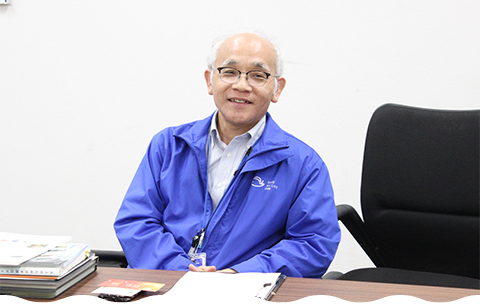 〈 Director Nishikiori during the interview 〉
〈 Director Nishikiori during the interview 〉
A. I have loved living creatures ever since I was a little kid, and I used to often play by the water. That was part of why I decided to study fisheries at university. I was born and raised in Tokyo, and I was seeking a job position that would let me apply my expertise here in my hometown. There was a job opening to do fisheries-related work with the Tokyo Metropolitan Government, but I didn’t get hired the first time I applied. I temporarily found a different job, but out of strong desire to do something that helps as many people as possible, so I reapplied and got hired the second time around.
 〈 Director Nishikiori during the interview 〉
〈 Director Nishikiori during the interview 〉
A. Tokyo Sea Life Park has its root in Ueno Zoological Gardens, Japan’s first zoo. It had a facility called “Uonozoki”, which similarly was Japan’s first aquarium. In commemoration of the 100th anniversary of the opening of the zoo, a decision was made to further develop the aquarium, resulting in the establishment of Tokyo Sea Life Park in 1989 inside Kasai Rinkai Park in Edogawa City, Tokyo. Tokyo Sea Life Park could be considered the successor to Japan’s first-ever aquarium.
Tokyo Sea Life Park has several unique features. One of the exhibits is called “Seas of the World.” The oceans contain a broad range of marine environments, encompassing the polar seas of the Arctic and Antarctic as well as the Atlantic and Pacific Oceans, and beyond. But, here, visitors are able to see creatures from all of these regions in one place. Another feature is the park’s role as a venue where visitors can interact with the sea. For people living in urban areas, the ocean may seem distant and irrelevant. But we hope is that by visiting Tokyo Sea Life Park, people will begin to feel closer to and more familiar with the sea.
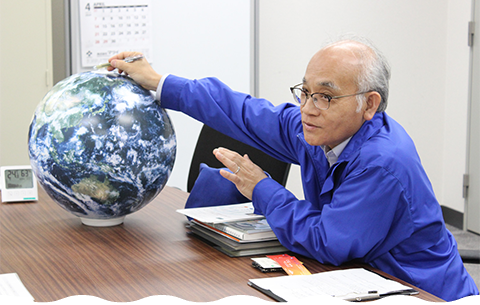
A. Tokyo encompasses a large portion of the nearby sea, among which the creatures of the Ogasawara Islands and their surrounding waters are particularly unique. Many unique creatures inhabit this diverse environment, such as the wrought-iron butterflyfish (Chaetodon daedalma) and a genus of endemic land snails known as Euhadra. However, as the habitat environment is becoming increasingly harsh, efforts are being made to increase the populations of these creatures in other locations. After identifying the living conditions of the creatures through field work and obtaining permission to collect some as samples, we raise and breed them in tanks in cooperation with other zoos operated by the Tokyo Metropolitan Government. We also introduce this process through exhibits. We would like to continue to provide the public with information about Tokyo’s sea through our various aquarium exhibits, and we feel that this is a very meaningful thing to do. We see this as one of our missions as an aquarium in Tokyo.
 〈 Director Nishikiori giving an explanation on the seas of Tokyo 〉
〈 Director Nishikiori giving an explanation on the seas of Tokyo 〉
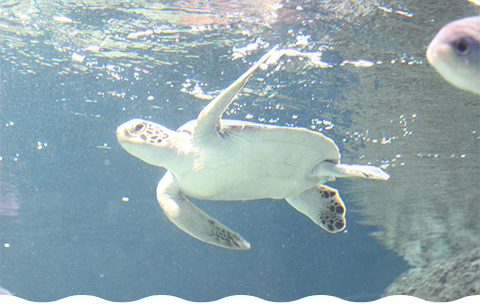
A. Green sea turtles have very long lifespans, and they are known for needing to be several decades old before they are able to lay eggs and breed. Since we can’t keep them forever in our current facilities, we bring in hatchlings bred in their native habitat and raise them here until they are big enough to avoid being preyed upon. Then we tag and release them back where they were born. We continue with this cycle because it is believed that the green sea turtles will only be able to avoid being preyed upon following release and return to the wild once they reach a certain size.
 〈 Green sea turtles on display 〉
〈 Green sea turtles on display 〉
A. First, proper packing is crucial in protecting the creatures during transport. We ensure that the style of packing is appropriate for the type and size of the creatures, and we take great care to maintain the optimal environment while underway. It is also necessary to maintain strict control of the oxygen supply and temperature. We set the parameters based on the specific creatures being transported in order to ensure the necessary amount of oxygen and maintain an appropriate temperature. We also take various other measures to protect the creatures from stress, such as deliberately staggering the timing and duration of transportation as necessary.
A. Yes, I have. I have been to both islands once each. I went to conduct surveys when I was a researcher at what is now the Tokyo Metropolitan Islands Area Research and Development Center for Agriculture, Forestry, and Fisheries (Ogasawara Fisheries Center).
A. Getting to the islands was very difficult because transportation is limited. We have access by a ship (MIYAKO, a research vessel operated by the Tokyo Metropolitan Government) that first goes from Oshima to Ogasawara before traveling the approximately 1,000 kilometers to the islands, which is so far that it has to be refueled midway. I remember that the trip took a very long time. At that time, members of the Self-Defense Forces, the Japan Meteorological Agency, and the Japan Coast Guard were stationed on Minamitorishima Island, and there was only a single runway in the center of the island where airplanes could land. I remember that Minamitorishima Island was extremely hot. Senior staff members were in charge of underwater surveys, while I was assigned to conduct surveys on land, so I almost burned the soles of my feet on the scorching hot sandy beach.
A. Even small children showed a great deal of interest, and some spent a very long time looking at the displays. Since neither Okinotorishima Island nor Minamitorishima Island are very well known, I felt that the method of first raising interest before providing information was particularly effective. Of course, as Tokyo Sea Life Park, we would like people to see actual creatures as much as possible. However, I felt that this manner of PR is a good way of first gaining understanding and raising interest.
A. Tokyo encompasses a vast and very diverse portion of the nearby sea, from Minamitorishima Island marking Japan’s easternmost point to Okinotorishima Island marking its southernmost point. We will continue to provide exhibits and engage in projects that are stimulating and give visitors a sense of the rich variety of creatures that inhabit the sea within the boundaries of Tokyo and how they currently live.
A. Since people of all ages visit Tokyo Sea Life Park, we always narrow down the target audience before creating a program. However, the main focus is on displays. In addition, when providing information, our fundamental goal is to provide accurate information about the natural world. While it is necessary to limit the amount of information displayed, including the common names and scientific names of creatures, we aim to provide new information as it comes to light in order to increase people’s interest in the creatures. On top of that, we also provide additional information that we particularly want people to see. These efforts are a part of our educational outreach program, and we are currently working to develop a range of programs each tailored for people of different age groups. We also post information on our website and social media accounts (X, Instagram, etc.) for people who are unable to visit in person or who are thinking of visiting in the future. We have also uploaded more than 200 videos to our YouTube channel, some of which have been released as educational materials for use in schools. They are available for teachers to show in class or on other occasions. Since people tend to view sea life parks as less casual than zoos, we are working hard to devise ways to provide information in a more accessible manner.
A. We are currently offering restaurant dishes that commemorate our 35th anniversary. The theme is “Our Past and Our Future,” and some of the dishes are revivals of nostalgic dishes that used to be served long ago. We have also set up a request box, so if you make a request, it just might be met…
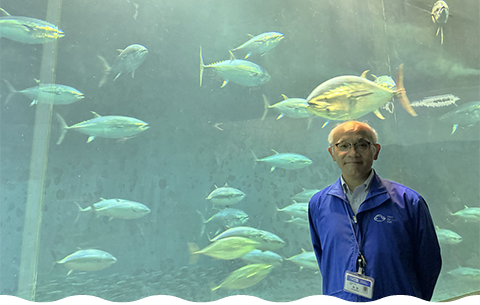
A. Tokyo Sea Life Park is celebrating its 35th anniversary in 2024. Last year, the cumulative number of visitors crossed the 60 million mark, as Tokyo Sea Life Park attracts many visitors through displaying not only creatures from around the world but also that live within the boundaries of Tokyo. While it may be difficult to experience when in the urban landscape of Tokyo, a visit to Tokyo Sea Life Park will help you feel closer to Tokyo’s as-yet-unknown marine environments, including Okinotorishima Island and Minamitorishima Island. We would like for you to see, hear, and smell these living creatures to experience their wonders through all of your senses.
 〈 Director Nishikiori in front of a tank displaying a school of tuna 〉
〈 Director Nishikiori in front of a tank displaying a school of tuna 〉